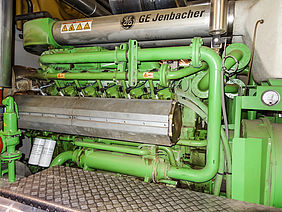General Electric is a leading global high-tech industrial company which provides products and services ranging from aircraft engines, power generation and oil and gas production equipment to medical imaging, financing and industrial products. The company was incorporated in 1892 and now serves customers in over 180 countries and employs approximately 283,000 people worldwide. Manufacturing operations are carried out at 162 manufacturing plants located in 34 states in the United States and Puerto Rico and at 297 manufacturing plants located in 41 other countries.
To the industrial operating segments of the company belong: Power Oil & Gas, Lighting, Renewable Energy, Healthcare, Aviation and Transportation.
The Renewable Energy Sector includes:
- Onshore wind, providing wind turbine platforms, hardware and software to optimize wind resources,
- Offshore wind, offering high-yield offshore wind turbines,
- Hydro, providing products and services to serve the hydropower industry and hydropower plants,
- LM Wind Power, manufacturing blades for onshore and offshore wind turbines.
According to the Annual Financial Report, consolidated revenues of the company were $121.6 billion, up $3.4 billion, or 3% in 2018, driven by increased industrial segment revenues of $2.5 billion and increased financial services revenues of $0.5 billion or 5%. The overall foreign currency impact on consolidated revenues was an increase of $0.6 billion.
Industrial segment revenues increased from $113.2 billion in 2017 to 115.7, by $2.5 billion or by 2% in 2018, driven principally by Aviation, Healthcare, Renewable Energy and Oil & Gas segments, partially offset by its Power, Transportation and Lighting segments.
Continuing earnings per share was $(2.43) in 2018 compared to $(0.99) in 2017 and decreased by 245%, primarily due to impairment charges of $22.4 billion, related to goodwill in Power Generation, Grid Solutions and Hydro reporting units as well as decreased profit of $1.4 billion in the Industrial Segment. Excluding the goodwill impairment charge, adjusted earnings per share was $0.65.
In 2018, consolidated continuing earnings decreased by $12.5 billion, or 246%, and the losses amounted to $21.2 billion compared to $8.6 billion in 2017, driven by goodwill impairment charges of $22.4 billion. Profit (loss) margins were (17.4%) in 2018, compared to 1.3% margins in 2017.
Industrial segment profit decreased by $1.4 billion, or 12%, from $12.2 billion in 2017 to $10.8 billion in 2018, primarily due to lower results within Power, Renewable Energy and Transportation segments.
The renewable energy market remains competitive, particularly in onshore wind. In the sector of Renewable Energy, revenues of General Electric grew by 4% from $9,205 million in 2017 to $9,553 million in 2018, and the company was recognized as the No. 1 wind turbine manufacturer in the United States in 2018. Revenues also increased due to the acquisition of LM Wind Power, a Danish supplier of rotor blades to the wind industry, in April 2017, which contributed $0.1 billion of inorganic revenue growth in the first half of 2018. However, profitability in the sector of Renewable Energy fell by 51% from $583 million in 2017 to $287 million in 2018. The decrease in profit was due to pricing pressure, an unfavorauble business mix as well as liquidated damages related to partner execution and project delays.
The renewable energy market is highly competitive, particularly in onshore wind, resulting in significant pricing pressure. Pricing for Onshore Wind business was down in 2018 due to the impact of auctions in many international markets and the competitive environment across all renewable sources.
Renewable energy is in a rapid transition period to become a source of energy, successfully competing in the marketplace against conventional energy sources. Wind energy is now the second-largest contributor to renewable capacity growth, while hydropower is projected to remain the largest renewable electricity source through to 2023.
However, continued competitive pressure from other wind and hydro turbine manufacturers as well as from other energy sources, such as solar photovoltaic, increases price pressure and the need for innovation.
As a result, General Electric is investing to keep renewable energy competitive by exploring new ways of further improving the efficiency and flexibility of hydropower technology with digital solutions and by moving forward with wind turbine product improvements, including larger rotors, taller towers and higher nameplate ratings that continue to drive down the cost of wind energy.
General Electric believes that North America will continue to be a solid market and expects additional opportunities to “repower” existing wind turbines. The Company is seeing excellent operating performance of those repowered turbines throughout its broad customer base and focused on improving margins by driving better productivity and reducing cost.
